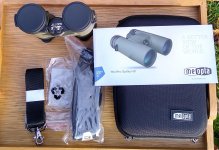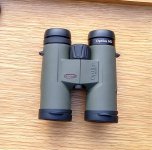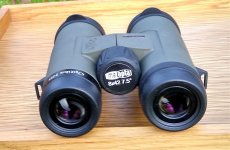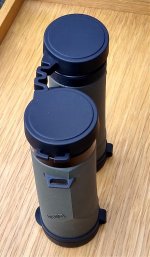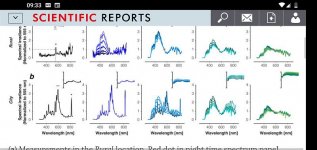The Optika HD is a totally new binocular that was launched by Meopta this summer. At present, the limited stock has only been distributed in the US, and is only available in the UK as a special order, but I’ve been assured that the “rest of the world", or Europe at least, will get it in due course as supply allows. The recommended European price is €299 and €319 for the 8x42 and 10x42 respectively, and the US online prices appear to be just below $300.
I got a brief look at both the 8x42 and 10x42 at the UK Birdfair in August. Of all the models I tried that day it was probably the one that surprised and intrigued me the most. There is quite a lot of competition at this price point, and is seems Meopta have decided to cut their own path rather than follow the pack. I suspect this binocular wasn’t designed with birders in mind, but that really doesn’t mean they should be overlooked. It’s got a lot to offer. I’m indebted to Miloš Slaný, Meopta Product Manager, for the loan of this review sample.
Listed specification.
Model 8x42
Field of View: 131m/393ft at 100m/yds, or 7.5°
Eye relief: 17mm *
Close focus: 2.5m/8.3ft *
IPD range: 56mm to 74mm
Height: 138mm/5.4” *
Weight: 650g/22.9oz*
https://www.meoptasportsoptics.eu/en/produkt/optika-hd-8x42-13197/
* My own estimates differed from the listed specification and will be discussed below.
Look and feel.
The Optika HD is a rather distinctive looking binocular. A dark shade of olive, or perhaps Loden green, with black trim. The bridge carries the usual Meopta badge as well as “Optika Meopro” moulded into the armour, and there is a second moulded Meopta logo on the left barrel. In case we missed it, there is another Meopta logo printed on the focus wheel, and yet one more on the hinge cap. The dioptre ring carries “Optika HD” on the dioptre ring and serial number on the reverse, and on the underside near the hinge there is “Meopta Czech Republic”. I guess we won’t be confusing it with any other brand or model!
The armour has a good thickness and resilience and should offer a bit more protection than some. The upper surface is modestly textured but somewhat smoother underneath. There is an edge to the moulding that fits well into the joint between thumb and finger, at an average IPD. The focus knob has bold alternate arrowhead shaped patterning, which seems a little out of line with the rest of the styling, but proved to be better with gloves than a couple of my other binoculars with more a more subtle designs.
Meopta say in their product description that the Optika HD has a robust magnesium alloy construction. It certainly feels more solidly made and well protected than some on the market, but I have no means to test their claims.
I think most experienced users would quite quickly realise the binocular is not as small or light as the official specification suggests. I make it 143mm or 5.63” tall and 730g/25.75oz on my kitchen scale. Taller and heavier than listed, so it doesn’t rank alongside the more compact x42s on the market, but still a relative lightweight compared to my usual x42s. The lens caps and rain guard fit well, but the compound is a little stiffer than some, making the rain guard a little slow to fit and lens caps inclined to reattach when bouncing against my chest or sitting down..
The case is a dark grey, fairly rigid clamshell with adequate room for a few accessories. Fine for transportation, but I feel a little bulky to carry around. I haven’t used any of the included accessories, but the neck-strap seems broad, shaped, padded, and perhaps unsurprisingly, decorated with a big bold Meopta logo. It looks like it should be more than adequate for a binocular of this weight.
The mechanical bits
All very good. The hinge has good holding tension. The focus is light and smooth with no backlash. From a close focus of this sample is 2.3m/7.6ft, and from there to 5m/16.4” is about a 180° anticlockwise and a fairly fast 120° from there to infinity. The dioptre adjustment is listed as +/- 4D. There is no locking mechanism, but there is a high level of stiction making accidental movement very unlikely. The eyepiece lens is approximately 5mm below the base level of the eyecup which twists out as additional racheted steps to make 8mm, 11.5mm and 14mm from the eyepiece lens compared to the 17mm listed ER.
I asked if they could tell me about where the component parts were sourced and assembled and got the following reply. “As the price indicates, these binoculars need extensive outsourcing. Nevertheless, the final works and detailed outgoing inspection is done in Meopta facility.” Whoever is responsible, it looks to me like they did an excellent job, particularly for this price level.
I know there are those from colder countries who are interested in how a binocular functions in sub-zero temperatures. After a night in the freezer, the focus was stiffer but was still very usable, the dioptre adjustment needed more force, but could still be moved, and the hinge seemed unaffected by the cold.
Optical properties
This is where the Oprika HD starts to show it’s distinctive character.
This is not a flat field design, but the field curvature is rather shallow with virtually no astigmatism at the edges. It means that in bright conditions, the depth of field means the sweet spot appears to almost reaches edge to edge. The sweet spot is still pretty generous at lower light levels, when the edges can still be refocused to a sharp image. The level of pincushion distortion seems a little lower than some of my other binoculars but still appears sufficient for my eyes to prevent the rolling ball effect. The level of chromatic aberration is unusually low. I didn’t notice it at all in several hours of birding in a whole variety of light conditions, but sure enough, if you look hard enough, you can find it. It’s just narrower, paler and more peripheral than any of the other binoculars I currently own. Meopta acknowledge low dispersion glass is used in the design but didn’t elaborate on the details.
Although the instrument resolution is quite typical for the price at around 200/D it is actually a very respectable 133/D when stopped down, as it would be by the pupil of the eye in bright conditions. Not surprisingly, it’s no match the top of the range Meostar HD I reviewed a couple of years ago, but should be more than good enough to satisfy the large majority of users.
The effective eye relief of binoculars is not a constant, and I’m told different companies measure it differently and therefore the specifications are not comparable. For all I own and have tested the ER effectively increases as the pupil of the eye dilates in low light. The Meopta value of 17mm is by the ISO method and corresponds to the ER in bright conditions. The low light value for the full exit pupil, that some other companies measure, it was 20mm. With my close fitting glasses I needed to twist out the eyecups about 1mm in bright conditions, and another few millimetres to just beyond the first stop in low light to prevent blackouts. Without glasses, it means in low light I need to rest the binoculars against my brow rather than seated in the eye socket.
In certain light conditions, particularly when the eye strays off centre there can be a faint circular peripheral zone of stray light. This review sample is much better than the one I tried at Birdfair and hasn’t troubled me, but is perhaps something to watch out for.
Possibly the most unusual aspect of these binoculars is the light transmission. Meopta sent me revised values for the integral of the daylight (photopic) and twilight (scotopic) of 90% and 88% respectively which is an improvement on the values listed on their website. Petty good, but not remarkable. It is the spectral profile which strikes me as unusual. In good daylight the effect is subtle. The first impression is that the color balance is quite neutral, but on a closer look I can tell some reds can look a little orange. The browns can either seem a bit greener, or even a little more purple but nothing very significant. However as daylight shifts to shorter wavelengths in overcast conditions, and particularly before dawn and after sunset, the colour balance of the Optika becomes obviously cooler, but appears to compliment the conditions, so can seem distinctly brighter.
Meopta have shown me a transmission profile which appears to explain my observations. The curve is essentially flat at a fraction above 90% between 500nm and 645nm. That is from cyan through to mid red. Below 500nm the transmission remains good, above 80% through the entire blue spectrum, right down to 410nm in the violet. Above 650nm the drop in transmission is much more abrupt, falling below 80% by 660nm. This kind of profile seems very unusual for binoculars in this price category, but it does remind me of a couple of models costing many times more. I’m not suggesting the Optika would match those premium designs for performance, but it might suggest a common design rationale.
I should point out that individuals differ in their sensitivity and ability to distinguish colour, particularly at the shorter and longer wavelengths, so others are bound to have different opinions on the Optika HD colour profile than I do.
In the Field
In the three weeks I’ve had the Optika HD we’ve had a lot of rain, many very gloomy days and just a couple of bright sunny ones and I feel I’ve been able to give them a pretty decent workout, given the time of year. I did take along one of my own mid-priced binoculars on a few outings to see how they stacked up, but that is rather cumbersome. Most side by side comparisons were done with my feeders, which are very busy this time of year.
Though not really a light weight, the Optika HD is about 90g/3oz lighter and 10mm/0.4” shorter than my usual binocular and felt a little better balanced. I just felt just a little more maneuverable in use, with no penalty in increased shake that I could detect. The focus is marginally faster focus too, and I’m sure I was getting on target faster with the Optika, but the difference was probably only milliseconds. I like the ability to cover 5m to infinity with one finger movement, especially as I walk the fields and hedgerows near where I live. The lakes of the reserves along the Lee valley pose a different challenge, but I didn’t find the fast focus speed any handicap as individual birds snapped nicely into focus, even in low contrast situations. Certain avian features just seemed slightly highlighted compared to my regular binocular, like the iridescent green of a Mallard’s head, or the yellow eye and blue bill of the Tufted duck. In certain light, particularly around sunset and early twilight the Optika did seem to have a modest advantage in apparent brightness and contrast. In the pale orange glow just after sunset, Goldfinch, Yellowhammers and male Chaffinch seemed to stand out like beacons in the hedgerows. Even the dowdy Dunnock seemed just a little more obvious. However, at least on one occasion as daylight faded away and the reflected sunlight off the clouds shifted into the deeper red the Optika lost a bit of contrast and sharpness compared to another binocular I own. This was way past the time of day I would normally be birding.
While watching the visitors to my feeders in bright, sunny conditions there was little to choose between the Optika and three other, slightly more expensive binoculars I own. However, things were a little more interesting when the light deteriorated on distinctly wet and gloomy afternoons. Compared to the others, the Optika picked out the blue caps and sheen of the blue tits more clearly. The yellow chests of the tits and Greenfinch primaries just appeared a little more chrisply defined. The rosy chests of the male chaffinch, richer colour of the brambling and red faces of the goldfinch stood out clearly as well. Yet somehow it was the more muted greens, browns and off-white tints of the tits and finches that seemed just a bit more distinctive with the Optika than the other three. Whether the colours were more, or less natural in the poor autumn light is another matter, but I personally don’t mind a little help with ID’s in those conditions.
Final comment
Meopta have produced an affordable, compact and apparently robust binocular that does pretty well in good light, but unusually well in poor weather and around sunset. I’m sure Meopta had hunters in mind when they conceived this design, but I do my birding in poor weather and challenging light conditions too. I think they have made a bold move in their choice of transmission spectrum, but to quote Miloš Slaný “ Every advanced bino user knows that real quality is revealed during twilight. In daylight most binocular images look the same. And blue colour is much more important for twilight imaging than the red one.”
Yes, you can pay a lot more and potentially get the best of both worlds, but for me it’s a binocular that punches well above its weight, and I suspect will suit the pockets of a lot of people just fine.
I got a brief look at both the 8x42 and 10x42 at the UK Birdfair in August. Of all the models I tried that day it was probably the one that surprised and intrigued me the most. There is quite a lot of competition at this price point, and is seems Meopta have decided to cut their own path rather than follow the pack. I suspect this binocular wasn’t designed with birders in mind, but that really doesn’t mean they should be overlooked. It’s got a lot to offer. I’m indebted to Miloš Slaný, Meopta Product Manager, for the loan of this review sample.
Listed specification.
Model 8x42
Field of View: 131m/393ft at 100m/yds, or 7.5°
Eye relief: 17mm *
Close focus: 2.5m/8.3ft *
IPD range: 56mm to 74mm
Height: 138mm/5.4” *
Weight: 650g/22.9oz*
https://www.meoptasportsoptics.eu/en/produkt/optika-hd-8x42-13197/
* My own estimates differed from the listed specification and will be discussed below.
Look and feel.
The Optika HD is a rather distinctive looking binocular. A dark shade of olive, or perhaps Loden green, with black trim. The bridge carries the usual Meopta badge as well as “Optika Meopro” moulded into the armour, and there is a second moulded Meopta logo on the left barrel. In case we missed it, there is another Meopta logo printed on the focus wheel, and yet one more on the hinge cap. The dioptre ring carries “Optika HD” on the dioptre ring and serial number on the reverse, and on the underside near the hinge there is “Meopta Czech Republic”. I guess we won’t be confusing it with any other brand or model!
The armour has a good thickness and resilience and should offer a bit more protection than some. The upper surface is modestly textured but somewhat smoother underneath. There is an edge to the moulding that fits well into the joint between thumb and finger, at an average IPD. The focus knob has bold alternate arrowhead shaped patterning, which seems a little out of line with the rest of the styling, but proved to be better with gloves than a couple of my other binoculars with more a more subtle designs.
Meopta say in their product description that the Optika HD has a robust magnesium alloy construction. It certainly feels more solidly made and well protected than some on the market, but I have no means to test their claims.
I think most experienced users would quite quickly realise the binocular is not as small or light as the official specification suggests. I make it 143mm or 5.63” tall and 730g/25.75oz on my kitchen scale. Taller and heavier than listed, so it doesn’t rank alongside the more compact x42s on the market, but still a relative lightweight compared to my usual x42s. The lens caps and rain guard fit well, but the compound is a little stiffer than some, making the rain guard a little slow to fit and lens caps inclined to reattach when bouncing against my chest or sitting down..
The case is a dark grey, fairly rigid clamshell with adequate room for a few accessories. Fine for transportation, but I feel a little bulky to carry around. I haven’t used any of the included accessories, but the neck-strap seems broad, shaped, padded, and perhaps unsurprisingly, decorated with a big bold Meopta logo. It looks like it should be more than adequate for a binocular of this weight.
The mechanical bits
All very good. The hinge has good holding tension. The focus is light and smooth with no backlash. From a close focus of this sample is 2.3m/7.6ft, and from there to 5m/16.4” is about a 180° anticlockwise and a fairly fast 120° from there to infinity. The dioptre adjustment is listed as +/- 4D. There is no locking mechanism, but there is a high level of stiction making accidental movement very unlikely. The eyepiece lens is approximately 5mm below the base level of the eyecup which twists out as additional racheted steps to make 8mm, 11.5mm and 14mm from the eyepiece lens compared to the 17mm listed ER.
I asked if they could tell me about where the component parts were sourced and assembled and got the following reply. “As the price indicates, these binoculars need extensive outsourcing. Nevertheless, the final works and detailed outgoing inspection is done in Meopta facility.” Whoever is responsible, it looks to me like they did an excellent job, particularly for this price level.
I know there are those from colder countries who are interested in how a binocular functions in sub-zero temperatures. After a night in the freezer, the focus was stiffer but was still very usable, the dioptre adjustment needed more force, but could still be moved, and the hinge seemed unaffected by the cold.
Optical properties
This is where the Oprika HD starts to show it’s distinctive character.
This is not a flat field design, but the field curvature is rather shallow with virtually no astigmatism at the edges. It means that in bright conditions, the depth of field means the sweet spot appears to almost reaches edge to edge. The sweet spot is still pretty generous at lower light levels, when the edges can still be refocused to a sharp image. The level of pincushion distortion seems a little lower than some of my other binoculars but still appears sufficient for my eyes to prevent the rolling ball effect. The level of chromatic aberration is unusually low. I didn’t notice it at all in several hours of birding in a whole variety of light conditions, but sure enough, if you look hard enough, you can find it. It’s just narrower, paler and more peripheral than any of the other binoculars I currently own. Meopta acknowledge low dispersion glass is used in the design but didn’t elaborate on the details.
Although the instrument resolution is quite typical for the price at around 200/D it is actually a very respectable 133/D when stopped down, as it would be by the pupil of the eye in bright conditions. Not surprisingly, it’s no match the top of the range Meostar HD I reviewed a couple of years ago, but should be more than good enough to satisfy the large majority of users.
The effective eye relief of binoculars is not a constant, and I’m told different companies measure it differently and therefore the specifications are not comparable. For all I own and have tested the ER effectively increases as the pupil of the eye dilates in low light. The Meopta value of 17mm is by the ISO method and corresponds to the ER in bright conditions. The low light value for the full exit pupil, that some other companies measure, it was 20mm. With my close fitting glasses I needed to twist out the eyecups about 1mm in bright conditions, and another few millimetres to just beyond the first stop in low light to prevent blackouts. Without glasses, it means in low light I need to rest the binoculars against my brow rather than seated in the eye socket.
In certain light conditions, particularly when the eye strays off centre there can be a faint circular peripheral zone of stray light. This review sample is much better than the one I tried at Birdfair and hasn’t troubled me, but is perhaps something to watch out for.
Possibly the most unusual aspect of these binoculars is the light transmission. Meopta sent me revised values for the integral of the daylight (photopic) and twilight (scotopic) of 90% and 88% respectively which is an improvement on the values listed on their website. Petty good, but not remarkable. It is the spectral profile which strikes me as unusual. In good daylight the effect is subtle. The first impression is that the color balance is quite neutral, but on a closer look I can tell some reds can look a little orange. The browns can either seem a bit greener, or even a little more purple but nothing very significant. However as daylight shifts to shorter wavelengths in overcast conditions, and particularly before dawn and after sunset, the colour balance of the Optika becomes obviously cooler, but appears to compliment the conditions, so can seem distinctly brighter.
Meopta have shown me a transmission profile which appears to explain my observations. The curve is essentially flat at a fraction above 90% between 500nm and 645nm. That is from cyan through to mid red. Below 500nm the transmission remains good, above 80% through the entire blue spectrum, right down to 410nm in the violet. Above 650nm the drop in transmission is much more abrupt, falling below 80% by 660nm. This kind of profile seems very unusual for binoculars in this price category, but it does remind me of a couple of models costing many times more. I’m not suggesting the Optika would match those premium designs for performance, but it might suggest a common design rationale.
I should point out that individuals differ in their sensitivity and ability to distinguish colour, particularly at the shorter and longer wavelengths, so others are bound to have different opinions on the Optika HD colour profile than I do.
In the Field
In the three weeks I’ve had the Optika HD we’ve had a lot of rain, many very gloomy days and just a couple of bright sunny ones and I feel I’ve been able to give them a pretty decent workout, given the time of year. I did take along one of my own mid-priced binoculars on a few outings to see how they stacked up, but that is rather cumbersome. Most side by side comparisons were done with my feeders, which are very busy this time of year.
Though not really a light weight, the Optika HD is about 90g/3oz lighter and 10mm/0.4” shorter than my usual binocular and felt a little better balanced. I just felt just a little more maneuverable in use, with no penalty in increased shake that I could detect. The focus is marginally faster focus too, and I’m sure I was getting on target faster with the Optika, but the difference was probably only milliseconds. I like the ability to cover 5m to infinity with one finger movement, especially as I walk the fields and hedgerows near where I live. The lakes of the reserves along the Lee valley pose a different challenge, but I didn’t find the fast focus speed any handicap as individual birds snapped nicely into focus, even in low contrast situations. Certain avian features just seemed slightly highlighted compared to my regular binocular, like the iridescent green of a Mallard’s head, or the yellow eye and blue bill of the Tufted duck. In certain light, particularly around sunset and early twilight the Optika did seem to have a modest advantage in apparent brightness and contrast. In the pale orange glow just after sunset, Goldfinch, Yellowhammers and male Chaffinch seemed to stand out like beacons in the hedgerows. Even the dowdy Dunnock seemed just a little more obvious. However, at least on one occasion as daylight faded away and the reflected sunlight off the clouds shifted into the deeper red the Optika lost a bit of contrast and sharpness compared to another binocular I own. This was way past the time of day I would normally be birding.
While watching the visitors to my feeders in bright, sunny conditions there was little to choose between the Optika and three other, slightly more expensive binoculars I own. However, things were a little more interesting when the light deteriorated on distinctly wet and gloomy afternoons. Compared to the others, the Optika picked out the blue caps and sheen of the blue tits more clearly. The yellow chests of the tits and Greenfinch primaries just appeared a little more chrisply defined. The rosy chests of the male chaffinch, richer colour of the brambling and red faces of the goldfinch stood out clearly as well. Yet somehow it was the more muted greens, browns and off-white tints of the tits and finches that seemed just a bit more distinctive with the Optika than the other three. Whether the colours were more, or less natural in the poor autumn light is another matter, but I personally don’t mind a little help with ID’s in those conditions.
Final comment
Meopta have produced an affordable, compact and apparently robust binocular that does pretty well in good light, but unusually well in poor weather and around sunset. I’m sure Meopta had hunters in mind when they conceived this design, but I do my birding in poor weather and challenging light conditions too. I think they have made a bold move in their choice of transmission spectrum, but to quote Miloš Slaný “ Every advanced bino user knows that real quality is revealed during twilight. In daylight most binocular images look the same. And blue colour is much more important for twilight imaging than the red one.”
Yes, you can pay a lot more and potentially get the best of both worlds, but for me it’s a binocular that punches well above its weight, and I suspect will suit the pockets of a lot of people just fine.




